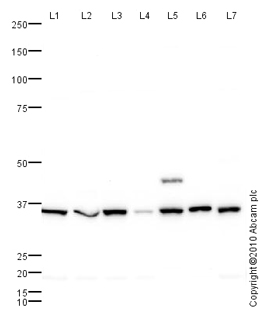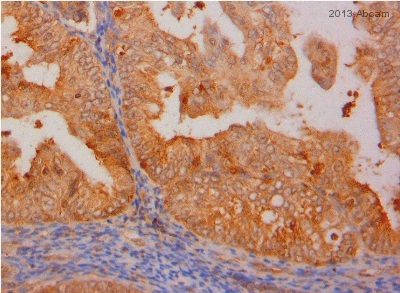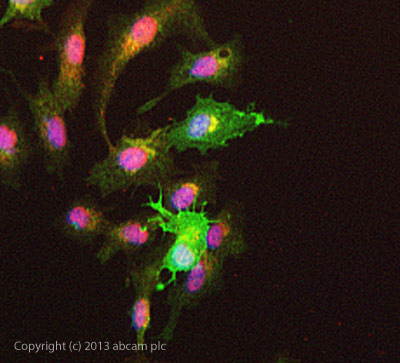
All lanes : Anti-AKR1B1 antibody (ab62795) at 1 µg/mlLane 1 : HeLa (Human epithelial carcinoma cell line) Whole Cell LysateLane 2 : Jurkat (Human T cell lymphoblast-like cell line) Whole Cell LysateLane 3 : HEK293 (Human embryonic kidney cell line) Whole Cell LysateLane 4 : Caco 2 (Human colonic carcinoma cell line) Whole Cell LysateLane 5 : Kidney (Human) Tissue Lysate - adult normal tissue (ab30203)Lane 6 : Placenta (Human) Tissue Lysate - adult normal tissue (ab29745)Lane 7 : MEL-1 (Human embryonic stem cell, male cell line) Whole Cell Lysate (ab27198)Lysates/proteins at 10 µg per lane.SecondaryGoat polyclonal to Rabbit IgG - H&L - Pre-Adsorbed (HRP) at 1/3000 dilutiondeveloped using the ECL techniquePerformed under reducing conditions.

ab62795 staining AKR1B1 in Human endometrial cancer tissue sections by Immunohistochemistry (IHC-P - paraformaldehyde-fixed, paraffin-embedded sections). Tissue was fixed with formaldehyde and blocked with 5% serum for 60 minutes at 25°C; antigen retrieval was by heat mediation in a citrate buffer. Samples were incubated with primary antibody (1/100 in 5% Gaot serum in TPBS) for 20 hours at 4°C. A Goat anti-rabbit IgG+IgM H+L polyclonal (1/100) was used as the secondary antibody.See Abreview

ICC/IF image of ab62795 stained HepG2 cells. The cells were 4% formaldehyde fixed (10 min) and then incubated in 1%BSA / 10% normal goat serum / 0.3M glycine in 0.1% PBS-Tween for 1h to permeabilise the cells and block non-specific protein-protein interactions. The cells were then incubated with the antibody ab62795 at 5µg/ml overnight at +4°C. The secondary antibody (green) was DyLight® 488 goat anti- rabbit (ab96899) IgG (H+L) used at a 1/1000 dilution for 1h. Alexa Fluor® 594 WGA was used to label plasma membranes (red) at a 1/200 dilution for 1h. DAPI was used to stain the cell nuclei (blue) at a concentration of 1.43µM.


